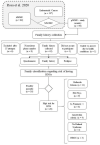Risk for Hereditary Neoplastic Syndromes in Women with Mismatch Repair-Proficient Endometrial Cancer
- PMID: 38002942
- PMCID: PMC10671603
- DOI: 10.3390/genes14111999
Risk for Hereditary Neoplastic Syndromes in Women with Mismatch Repair-Proficient Endometrial Cancer
Abstract
Endometrial cancer (EC) is a prevalent malignancy in women, and those who are proficient in the DNA mismatch repair (pMMR) pathway may have a family history (FH) that meets the criteria for a hereditary neoplastic condition (HNS). This study aimed to estimate the risk of HNS in women with pMMR endometrial tumors by analyzing their FH. To achieve this, we collaborated with a primary study and collected FH information by telephone. The final sample comprised 42 women who responded to the Primary Screening Questionnaire. Their family pedigrees were drawn and categorized according to internationally standardized criteria for the risk of HNS. Results showed that 26 women (61%) were found to be at risk for HNS, with Bethesda criteria being met by 23%, Amsterdam criteria by 15%, and 4% met the attenuated familial adenomatous polyposis criteria. Our results emphasize the importance of FH and the need to encourage healthcare professionals to collect and document FH more frequently, even if it is self-reported. By identifying individuals with HNS, we can improve their outcomes and reduce the burden of cancer in families with a predisposition to cancer.
Keywords: family history; lineage; patterns of inheritance; risk; uterine neoplasms.
Conflict of interest statement
The authors declare no conflict of interest.
Figures


Similar articles
-
Selection of endometrial carcinomas for DNA mismatch repair protein immunohistochemistry using patient age and tumor morphology enhances detection of mismatch repair abnormalities.Am J Surg Pathol. 2009 Jun;33(6):925-33. doi: 10.1097/PAS.0b013e318197a046. Am J Surg Pathol. 2009. PMID: 19238076
-
Frequency of extra-colonic tumors in hereditary nonpolyposis colorectal cancer (HNPCC) and familial colorectal cancer (FCC) Brazilian families: An analysis by a Brazilian Hereditary Colorectal Cancer Institutional Registry.Fam Cancer. 2004;3(1):41-7. doi: 10.1023/B:FAME.0000026810.99776.e9. Fam Cancer. 2004. PMID: 15131405
-
Molecular epidemiological and mutational analysis of DNA mismatch repair (MMR) genes in endometrial cancer patients with HNPCC-associated familial predisposition to cancer.Cancer Sci. 2008 Sep;99(9):1715-9. doi: 10.1111/j.1349-7006.2008.00886.x. Epub 2008 Jul 9. Cancer Sci. 2008. PMID: 18624996 Free PMC article.
-
Lynch syndrome (hereditary non-polyposis colorectal cancer) and endometrial carcinoma.J Clin Pathol. 2009 Aug;62(8):679-84. doi: 10.1136/jcp.2009.064949. J Clin Pathol. 2009. PMID: 19638537 Review.
-
[Hereditary colorectal cancer].Korean J Gastroenterol. 2005 Feb;45(2):78-87. Korean J Gastroenterol. 2005. PMID: 15725711 Review. Korean.
References
-
- Manning-Geist B.L., Gatius S., Liu Y., Gil M., Da Cruz Paula A., Tuset N., Abu-Rustum N.R., Aghajanian C., Weigelt B., Matias-Guiu X. Diagnosis and Management of an Endometrial Cancer Patient with Cowden Syndrome. Gynecol. Oncol. 2021;163:14–21. doi: 10.1016/j.ygyno.2021.08.008. - DOI - PMC - PubMed
Publication types
MeSH terms
Grants and funding
LinkOut - more resources
Full Text Sources
Miscellaneous

